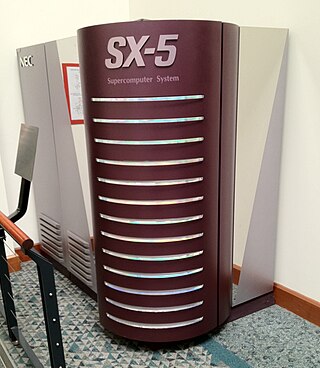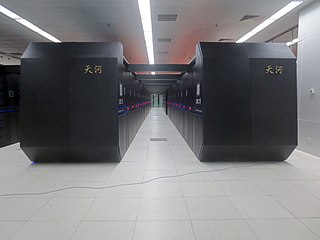Related Research Articles

A supercomputer is a computer with a high level of performance as compared to a general-purpose computer. The performance of a supercomputer is commonly measured in floating-point operations per second (FLOPS) instead of million instructions per second (MIPS). Since 2017, supercomputers have existed which can perform over 1017 FLOPS (a hundred quadrillion FLOPS, 100 petaFLOPS or 100 PFLOPS). For comparison, a desktop computer has performance in the range of hundreds of gigaFLOPS (1011) to tens of teraFLOPS (1013). Since November 2017, all of the world's fastest 500 supercomputers run on Linux-based operating systems. Additional research is being conducted in the United States, the European Union, Taiwan, Japan, and China to build faster, more powerful and technologically superior exascale supercomputers.

Blue Gene was an IBM project aimed at designing supercomputers that can reach operating speeds in the petaFLOPS (PFLOPS) range, with low power consumption.

Jack Joseph Dongarra is an American computer scientist and mathematician. He is the American University Distinguished Professor of Computer Science in the Electrical Engineering and Computer Science Department at the University of Tennessee. He holds the position of a Distinguished Research Staff member in the Computer Science and Mathematics Division at Oak Ridge National Laboratory, Turing Fellowship in the School of Mathematics at the University of Manchester, and is an adjunct professor and teacher in the Computer Science Department at Rice University. He served as a faculty fellow at the Texas A&M University Institute for Advanced Study (2014–2018). Dongarra is the founding director of the Innovative Computing Laboratory at the University of Tennessee. He was the recipient of the Turing Award in 2021.

High-performance computing (HPC) uses supercomputers and computer clusters to solve advanced computation problems.

NEC SX describes a series of vector supercomputers designed, manufactured, and marketed by NEC. This computer series is notable for providing the first computer to exceed 1 gigaflop, as well as the fastest supercomputer in the world between 1992–1993, and 2002–2004. The current model, as of 2018, is the SX-Aurora TSUBASA.

EPCC, formerly the Edinburgh Parallel Computing Centre, is a supercomputing centre based at the University of Edinburgh. Since its foundation in 1990, its stated mission has been to accelerate the effective exploitation of novel computing throughout industry, academia and commerce.

The TOP500 project ranks and details the 500 most powerful non-distributed computer systems in the world. The project was started in 1993 and publishes an updated list of the supercomputers twice a year. The first of these updates always coincides with the International Supercomputing Conference in June, and the second is presented at the ACM/IEEE Supercomputing Conference in November. The project aims to provide a reliable basis for tracking and detecting trends in high-performance computing and bases rankings on HPL benchmarks, a portable implementation of the high-performance LINPACK benchmark written in Fortran for distributed-memory computers.
The Green500 is a biannual ranking of supercomputers, from the TOP500 list of supercomputers, in terms of energy efficiency. The list measures performance per watt using the TOP500 measure of high performance LINPACK benchmarks at double-precision floating-point format.
Petascale computing refers to computing systems capable of calculating at least 1015 floating point operations per second (1 petaFLOPS). Petascale computing allowed faster processing of traditional supercomputer applications. The first system to reach this milestone was the IBM Roadrunner in 2008. Petascale supercomputers were succeeded by exascale computers.

The K computer – named for the Japanese word/numeral "kei" (京), meaning 10 quadrillion (1016) – was a supercomputer manufactured by Fujitsu, installed at the Riken Advanced Institute for Computational Science campus in Kobe, Hyōgo Prefecture, Japan. The K computer was based on a distributed memory architecture with over 80,000 compute nodes. It was used for a variety of applications, including climate research, disaster prevention and medical research. The K computer's operating system was based on the Linux kernel, with additional drivers designed to make use of the computer's hardware.

Several centers for supercomputing exist across Europe, and distributed access to them is coordinated by European initiatives to facilitate high-performance computing. One such initiative, the HPC Europa project, fits within the Distributed European Infrastructure for Supercomputing Applications (DEISA), which was formed in 2002 as a consortium of eleven supercomputing centers from seven European countries. Operating within the CORDIS framework, HPC Europa aims to provide access to supercomputers across Europe.
The LINPACK Benchmarks are a measure of a system's floating-point computing power. Introduced by Jack Dongarra, they measure how fast a computer solves a dense n by n system of linear equations Ax = b, which is a common task in engineering.
The PRIMEHPC FX10 is a supercomputer designed and manufactured by Fujitsu. Announced on 7 November 2011 at the Supercomputing Conference, the PRIMEHPC FX10 is an improved and commercialized version of the K computer, which was the first supercomputer to obtain more than 10 PFLOPS on the LINPACK benchmark. In its largest configuration, the PRIMEHPC FX10 has a peak performance 23.2 PFLOPS, power consumption of 22.4 MW, and a list price of US$655.4 million. It was succeeded by the PRIMEHPC FX100 with SPARC64 XIfx processors in 2015.
The number of traversed edges per second (TEPS) that can be performed by a supercomputer cluster is a measure of both the communications capabilities and computational power of the machine. This is in contrast to the more standard metric of floating-point operations per second (FLOPS), which does not give any weight to the communication capabilities of the machine. The term first entered usage in 2010 with the advent of petascale computing, and has since been measured for many of the world's largest supercomputers.

Appro was a developer of supercomputing supporting High Performance Computing (HPC) markets focused on medium- to large-scale deployments. Appro was based in Milpitas, California with a computing center in Houston, Texas, and a manufacturing and support subsidiary in South Korea and Japan.

Tianhe-2 or TH-2 is a 33.86-petaflops supercomputer located in the National Supercomputer Center in Guangzhou, China. It was developed by a team of 1,300 scientists and engineers.
The Graph500 is a rating of supercomputer systems, focused on data-intensive loads. The project was announced on International Supercomputing Conference in June 2010. The first list was published at the ACM/IEEE Supercomputing Conference in November 2010. New versions of the list are published twice a year. The main performance metric used to rank the supercomputers is GTEPS.

Fugaku(Japanese: 富岳) is a petascale supercomputer at the Riken Center for Computational Science in Kobe, Japan. It started development in 2014 as the successor to the K computer and made its debut in 2020. It is named after an alternative name for Mount Fuji.

Leonardo is a petascale supercomputer located at the CINECA datacenter in Bologna, Italy. The system consists of an Atos BullSequana XH2000 computer, with close to 14,000 Nvidia Ampere GPUs and 200Gb/s Nvidia Mellanox HDR InfiniBand connectivity. Inagurated in November 2022, Leonardo is capable of 250 petaflops, making it one of the top five fastest supercomputers in the world. It debuted on the TOP500 in November 2022 ranking fourth in the world, and second in Europe.
References
- ↑ Hemsoth, Nicole (June 26, 2014). "New HPC Benchmark Delivers Promising Results". HPCWire. Archived from the original on 2014-09-08. Retrieved 2014-09-08.
- ↑ Dongarra, Jack; Heroux, Michael (June 2013). "Toward a New Metric for Ranking High Performance Computing Systems" (PDF). Sandia National Laboratory. Archived from the original (PDF) on August 20, 2013. Retrieved 2016-07-04.
- ↑ Trader, Tiffany (2015-07-16). "LINPACK's 'Companion Metric' Gains Traction". HPCwire. Archived from the original on 2016-05-30. Retrieved 2016-07-04.
- ↑ Jackson, Adrian (30 July 2015). "HPCG: benchmarking supercomputers". www.epcc.ed.ac.uk. EPCC at the University of Edinburgh. Archived from the original on 2016-08-20. Retrieved 2016-07-04.
- ↑ Brueckner, Rich (2015-07-13). "Latest HPCG Performance List Complements TOP500". Inside HPC. Archived from the original on 2016-05-28. Retrieved 2016-07-04.
- ↑ "HPC-G source code". Github. Archived from the original on 11 June 2018. Retrieved 6 February 2019.
- ↑ "US Regains TOP500 Crown with Summit Supercomputer, Sierra Grabs Number Three Spot". Top500. Top500.org. Archived from the original on 25 March 2021. Retrieved 28 June 2018.
- ↑ "HPCG - November 2022 | TOP500". www.top500.org. Archived from the original on 2023-01-20. Retrieved 2023-02-08.